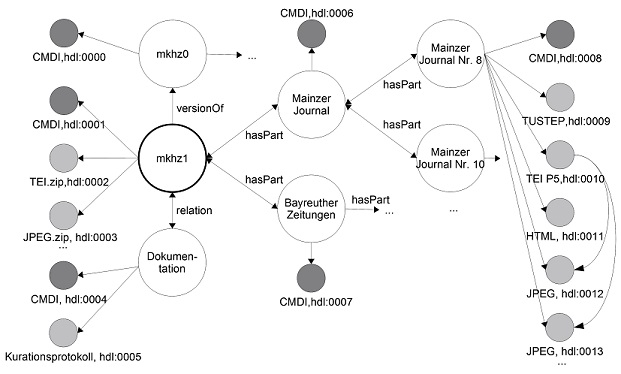| Version 14 (modified by , 10 years ago) (diff) |
|---|
VLO Facets
Relationships
The CMDI metadata framework provides a generic mechanism to represent (directional) relationships between objects: <ResourceProxy?>. A <ResourceProxy?> specifies the <ResourceType?> (one of "Landing Page", "Resource", "Metadata") and the target <ResourceRef?> of a relationship, which (usually) contains a URL, sometimes a PID (as a special case of a URL). A <ResourceProxy?> is equipped with an id attribute, which can be and is being used for specifying further information, such as a descriptive, human readable anchor text and its semantics (partOf, versionOf, source, ...) in the component part of a CMDI record. Finally, for some kinds of relationships, there exist some dedicated elements in the <Resources> section of a CMDI record:
- <isPartOfList> for specifying one direction of a partOf relationship.
- <JournalFileProxyList?> possibly for dealing with versioning (TODO: link to discussion on versioning)
- <Relations> for specifying the semantics (?) of all other kinds of relationships (TODO: examples?)
This huge, combinatorial design space for representing relationships has been creatively exhausted by the CLARIN-D Centers. As a consequence, the VLO is basically agnostic w.r.t. relationships.
In the following, some of the existing representations are analyzed, with the explicit goal of narrowing the design space and making some kinds of relationships more useful for the VLO.
HZSK
HZSK represents all resources of a corpus in one CMDI record. Thus, the target of a relationship (<ResourceRef?>) has always type (ResourceType?) Resource. The individual resources are further specified in the component part of the CMDI record by refering to the <ResourceProxy?> via its id attribute.
Example:
http://virt-fedora.multilingua.uni-hamburg.de/drupal/fedora/repository/cmdi:demo/cmdi/metadata.xml
<ResourceProxy id="ACDIMB865D8-D9BA-7F9B-E652-D00D960850B4"> <ResourceType mimetype="text/xml">Resource</ResourceType> <ResourceRef>http://hdl.handle.net/11858/00-248C-0000-000E-0181-F</ResourceRef> </ResourceProxy> ... <HZSKTranscription ComponentId="clarin.eu:cr1:c_1345561703658" ref="ID8392DD18-04C3-9DC7-A7F5-2FA8A3639EA4"> <Name>Rudi Völler Wutausbruch</Name> <TranscriptionConvention>HIAT (simplified)</TranscriptionConvention> ... </HZSKTranscription>
BAS
BAS represents the resources of a corpus by several CMDI records, and employs a variety of approaches to represent relationships:
- The relationship between the CMDI record for a corpus and its parts is specified explicitly in one direction by means of CMDI's built-in <isPartOf> element.
- Relationships with a target of type Resource are further specified in the component part of the CMDI record by referring to the <ResourceProxy?> via its id attribute
- Relationships between individual components, such as from <media-file> to <media-session-actor> are represented by referring to the target's id attribute as well.
Example:
https://clarin.phonetik.uni-muenchen.de/BASRepository/Public/Corpora/ZIPTEL/ZIPTEL.2.cmdi.xml
<ResourceProxy id="c_0000000001"> <ResourceType mimetype="text/xml">Metadata</ResourceType> <ResourceRef>https://clarin.phonetik.uni-muenchen.de/BASRepository/Public/Corpora/ZIPTEL/0001.2.cmdi.xml</ResourceRef> </ResourceProxy>
http://catalog.clarin.eu/oai-harvester/cmdi-providers/harvested/results/cmdi/Bayerisches_Archiv_f_r_Sprachsignale/oai_BAS_repo_Corpora_ZIPTEL_0001.xml or https://clarin.phonetik.uni-muenchen.de/BASRepository/Public/Corpora/ZIPTEL/0001.2.cmdi.xml
<ResourceProxy id="r_0000000001"> <ResourceType mimetype="audio/raw">Resource</ResourceType> <ResourceRef>https://clarin.phonetik.uni-muenchen.de/BASRepository/Corpora/ZIPTEL/0001/z10001z2.dea</ResourceRef> </ResourceProxy> ... <IsPartOfList> <IsPartOf>https://clarin.phonetik.uni-muenchen.de/BASRepository/Public/Corpora/ZIPTEL/ZIPTEL.2.cmdi.xml</IsPartOf> </IsPartOfList> ... <media-file actor-ref="s_0000000001" ref="r_0000000001"> <Type>audio</Type><Quality>3</Quality> <RecordingConditions>un-supervised answering of a question prompted via telephone</RecordingConditions> ... </media-file> ... <media-session-actor id="s_0000000001"> <Role>question answering</Role> <Name>unspecified</Name> <FullName>unspecified</FullName> <Code>0001</Code> ... </media-session-actor>
IDS-Mannheim
IDS-Mannheim represents resources by several CMDI records, and employs a variety of approaches to represent relationships:
- The first version of the historical newspaper corpus MKHZ represents relationships by <ResourceProxy?> as well as OLAC-Dcmi-Terms elements such as <hasPart>, where both point to a PID (see for example http://repos.ids-mannheim.de/fedora/objects/clarind-ids:mkhz.000000/datastreams/CMDI/content)
- The second version of the historical newspaper corpus represents relationships by <ResourceProxy?> and further specifies the semantics (and anchor text) of the relationship in the component part of the relationship (see for example http://repos.ids-mannheim.de/fedora/objects/clarin-ids:mkhz1.00000/datastreams/CMDI/content). The underlying conceptual model is depicted in the figure below.
- Relationships in the corpora of spoken language are represented by ResourceProxy?'s only, and partOf relationships are further specified by means of CMDI's built-in <IsPartOf?> element (see for example http://repos.ids-mannheim.de/fedora/objects/clarin-ids:folk.FOLK_S_00248.cmdi/datastreams/CMDI/content)
Leibzig
TBD when the webservice is available again.
Summary on Representation of Relationships
TBD.
Example Profiles
Background Information
Attachments (7)
-
facets.ods (15.5 KB) - added by 10 years ago.
Summary of desired facets for the VLO (15.10.2013)
-
VLO_facets.pdf (30.4 KB) - added by 10 years ago.
VLO facets with ISO Cats (9.10.2013)
-
VLO_Tischvorlage_2014-01-07.pdf (242.2 KB) - added by 10 years ago.
Summary of VLO data curation issues and plans (7.1.2014)
-
abbildung3.jpg (605.3 KB) - added by 10 years ago.
conceptual model of MKHZ representation
-
mkhz-representation.jpg (63.2 KB) - added by 10 years ago.
conceptual model of MKHZ representation (small)
-
Gruppe Vokabular_v3.pdf (44.5 KB) - added by 10 years ago.
3rd draft of vocabulary recommendations (in German)
-
time_coverage.pdf (241.8 KB) - added by 10 years ago.
Time Coverage: Definition, Use Cases, VLO Interface, Data Categories, Components
Download all attachments as: .zip

